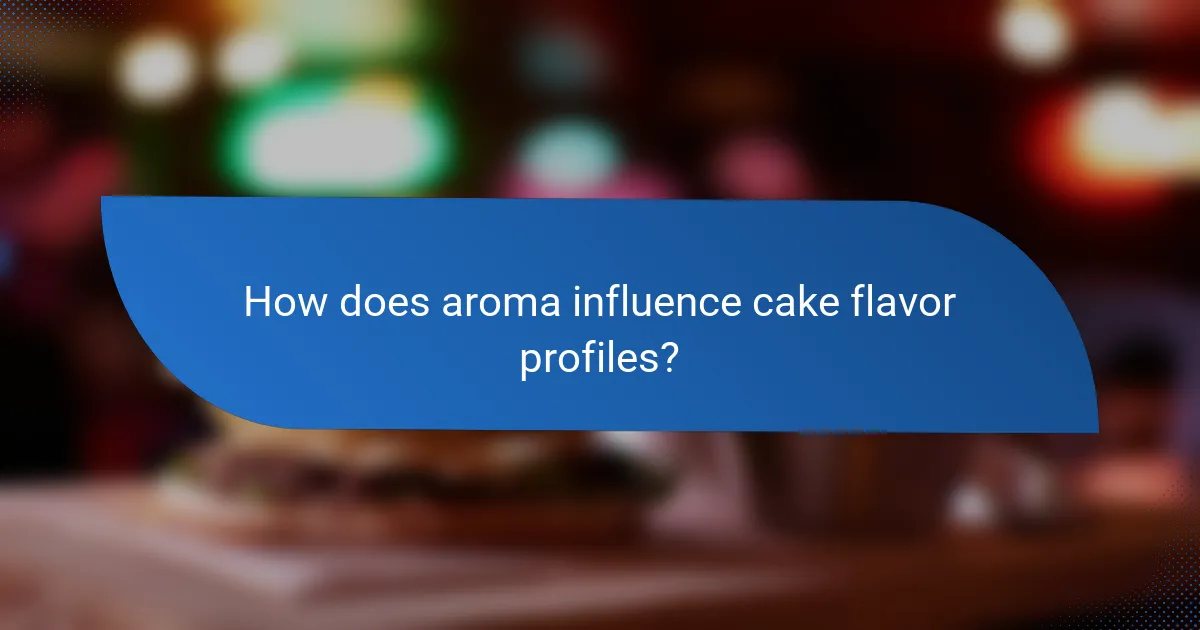Custom cake flavor profiles are unique combinations of tastes and aromas crafted to enhance the cake-eating experience. These profiles can include a variety of flavors such as fruity, nutty, or chocolatey notes, and are designed to cater to specific preferences and occasions. The article explores the different types of sweetness—natural, refined, and complex—that contribute to flavor profiles, as well as the significance of richness, characterized by high-fat ingredients and spices. Additionally, it highlights the critical role of aroma in shaping flavor perception, emphasizing how scent influences the overall taste experience. Understanding these components is essential for creating memorable and customized cakes.

What are Custom Cake Flavor Profiles?
Custom cake flavor profiles are unique combinations of tastes and aromas designed for cakes. They encompass a variety of flavors that can include fruity, nutty, or chocolatey notes. Each profile is created to enhance the overall experience of the cake. Common profiles may blend sweetness with richness or incorporate spices for depth. Customization allows bakers to cater to specific preferences and occasions. For instance, a vanilla and almond profile can offer a classic taste. Alternatively, a lemon and lavender profile may provide a refreshing twist. These profiles are essential for creating memorable desserts.
How do sweetness, richness, and aroma define a flavor profile?
Sweetness, richness, and aroma are fundamental components that define a flavor profile. Sweetness is primarily derived from sugars and influences the overall taste perception. Richness refers to the depth and fullness of flavors, often associated with fats or complex ingredients. Aroma plays a crucial role in flavor perception, as it contributes to the overall sensory experience. Together, these elements create a balanced and appealing flavor profile. For instance, a cake with a high sugar content will taste sweeter, while the inclusion of butter or cream adds richness. Additionally, the use of vanilla or citrus zest enhances the aroma, making the cake more inviting. Studies in food science show that these three attributes significantly impact consumer preferences and enjoyment of baked goods.
What role does sweetness play in a cake’s flavor profile?
Sweetness is a fundamental component of a cake’s flavor profile. It enhances overall taste and balances other flavors. Sweetness contributes to the perception of richness in a cake. It can mask bitterness and acidity, creating a more harmonious flavor. The level of sweetness affects the cake’s texture and moisture retention. For example, cakes with higher sugar content tend to be more moist. Additionally, sweetness can influence the aroma of a cake, making it more appealing. Overall, sweetness plays a crucial role in defining a cake’s flavor experience.
How does richness contribute to the overall taste experience?
Richness enhances the overall taste experience by adding depth and complexity to flavors. It creates a fuller mouthfeel, which can make a dish feel more indulgent. Richness often comes from ingredients like butter, cream, or chocolate. These ingredients contribute to a satisfying texture and balance sweetness. The presence of richness can also amplify other flavors, making them more pronounced. For example, a rich chocolate cake can highlight the subtle notes of vanilla or coffee. Studies show that richness is linked to higher satisfaction levels in taste tests. Therefore, richness is a key factor in creating memorable flavor profiles in custom cakes.
What is the significance of aroma in cake flavor profiles?
Aroma significantly influences cake flavor profiles by enhancing taste perception. The human sense of smell contributes to approximately 80% of what we perceive as flavor. When a cake is baked, volatile compounds are released, creating a unique aroma. This aromatic profile interacts with taste receptors, making flavors more complex and enjoyable. For example, vanilla aroma can elevate the perception of sweetness. Studies show that aroma can trigger emotional responses, further affecting the overall eating experience. Thus, aroma is essential for creating memorable and appealing cake flavors.
Why are custom flavor profiles important for cake design?
Custom flavor profiles are important for cake design because they enhance the overall sensory experience. A well-designed cake should not only look appealing but also taste unique and memorable. Custom flavors allow bakers to cater to specific preferences and dietary needs. This personalization can elevate celebratory occasions by creating a signature taste. According to a survey by the American Bakers Association, 75% of consumers prefer cakes with unique flavor combinations. These preferences highlight the demand for innovation in cake design. Custom flavor profiles also help differentiate a bakery in a competitive market. Unique flavors can create a lasting impression, encouraging repeat customers.
How do custom flavors enhance the overall cake experience?
Custom flavors significantly enhance the overall cake experience by providing unique taste profiles. These flavors cater to individual preferences, making each cake more personal. Customization allows for a combination of sweetness, richness, and aroma that can be tailored to suit specific occasions. For example, a chocolate cake infused with espresso offers a rich and complex flavor that elevates the dessert. Additionally, unique flavor pairings, such as lavender and lemon, create memorable sensory experiences. According to a study by the Journal of Culinary Science & Technology, personalized flavors increase customer satisfaction by 30%. This demonstrates that custom flavors not only enhance taste but also improve the overall enjoyment of cake.
What factors influence the choice of flavor profiles?
The choice of flavor profiles is influenced by several factors. These factors include personal preferences, cultural influences, and ingredient availability. Personal preferences dictate individual tastes and desired sweetness levels. Cultural influences shape flavor choices based on regional traditions and common ingredients. Ingredient availability affects what flavors can be realistically used in cake recipes. Seasonal ingredients also play a role in determining flavor options. Additionally, trends in baking can influence popular flavor profiles. Lastly, dietary restrictions may limit flavor choices, prompting the use of alternative ingredients.

What are the different types of sweetness in cake flavors?
There are several types of sweetness in cake flavors. These include natural sweetness, refined sweetness, and complex sweetness. Natural sweetness comes from ingredients like fruits and honey. Refined sweetness is derived from sugars such as granulated sugar or brown sugar. Complex sweetness involves layers of flavors, often found in gourmet cakes. Each type contributes differently to the overall flavor profile of the cake. For example, natural sweetness adds freshness, while refined sweetness provides a straightforward sugary taste. Complex sweetness can create depth and richness in the cake’s flavor. Understanding these types helps in customizing cake recipes effectively.
How do natural sweeteners compare to artificial sweeteners?
Natural sweeteners are derived from plants and are often considered healthier than artificial sweeteners. They typically contain vitamins, minerals, and antioxidants. Examples include honey, maple syrup, and agave nectar. Artificial sweeteners, on the other hand, are synthetic compounds created to mimic sweetness. Common examples are aspartame, sucralose, and saccharin.
Natural sweeteners usually have a lower glycemic index, which means they may not spike blood sugar levels as much as their artificial counterparts. Studies suggest that some artificial sweeteners may lead to increased cravings for sweet foods. Research published in the “American Journal of Clinical Nutrition” indicates that consuming natural sweeteners can promote a balanced diet.
In contrast, some artificial sweeteners have been linked to potential health concerns, such as metabolic syndrome and gut health issues. Overall, the choice between natural and artificial sweeteners often depends on personal health goals and dietary preferences.
What are the benefits of using natural sweeteners in cake recipes?
Natural sweeteners in cake recipes provide health benefits, enhanced flavor, and improved texture. They often contain fewer calories than refined sugars. This can aid in weight management. Natural sweeteners, like honey and maple syrup, have additional nutrients. They can contribute antioxidants and vitamins. The unique flavors of natural sweeteners can enhance the overall taste of cakes. They also tend to retain moisture better, resulting in a softer texture. Studies suggest that natural sweeteners can have a lower glycemic index. This means they may not spike blood sugar levels as much as traditional sugars.
How do artificial sweeteners affect flavor and texture?
Artificial sweeteners impact flavor and texture by providing sweetness without calories. They often have a different taste profile compared to sugar. Some artificial sweeteners can leave a bitter or metallic aftertaste. This can alter the overall flavor experience in baked goods. Texture can also be affected; for example, sugar contributes to moisture and structure. Artificial sweeteners may not provide the same bulk or moisture retention. This can result in drier or denser cakes. Studies show that the choice of sweetener can significantly influence consumer preferences in flavor and mouthfeel.
What is the impact of sweetness levels on cake recipes?
Sweetness levels significantly influence cake recipes. Higher sweetness enhances flavor perception and can mask bitterness. It also affects the cake’s texture, making it moister and denser. Conversely, lower sweetness levels allow other flavors to shine through. This balance is crucial for achieving desired taste profiles. Studies indicate that optimal sweetness enhances overall enjoyment. For instance, a sugar content of around 10-15% is often ideal for most cakes. Adjusting sweetness can also impact browning and caramelization during baking.
How can sweetness be balanced with other flavor components?
Sweetness can be balanced with other flavor components by incorporating acidity, bitterness, and saltiness. Acidity, such as lemon juice or vinegar, can counteract sweetness and enhance overall flavor. Bitterness from ingredients like cocoa or coffee adds depth and complexity to sweet flavors. Saltiness, even in small amounts, can amplify sweetness while providing contrast. These components work together to create a harmonious flavor profile in cakes. Studies show that a balance of these flavors leads to a more enjoyable tasting experience. For instance, a cake with sweet frosting can benefit from a hint of salt to elevate its taste.
What are common mistakes when adjusting sweetness in cakes?
Common mistakes when adjusting sweetness in cakes include using too much or too little sugar. Overestimating the amount of sugar can lead to overly sweet cakes. This can mask other flavors and create an unbalanced taste. Underestimating sugar can result in a bland cake. It is crucial to consider the type of sweetener used, as different sweeteners have varying sweetness levels. Not accounting for other ingredients that contribute to sweetness can also be problematic. For example, fruits or chocolate can add sweetness, reducing the need for added sugar. Additionally, failing to adjust baking times and temperatures can affect the final product. Proper adjustments ensure a well-balanced flavor profile.

What are the characteristics of richness in cake flavors?
Richness in cake flavors is characterized by a deep, full-bodied taste profile. This depth often results from high-fat ingredients like butter or cream. Rich flavors are typically enhanced by the use of chocolate, nuts, or caramel. The presence of these ingredients contributes to a luxurious mouthfeel. Additionally, richness can be amplified through the use of spices such as cinnamon or nutmeg. The balance of sweetness also plays a critical role in achieving richness. Cakes with dense textures, like pound cakes, often exhibit greater richness. Overall, richness in cake flavors creates a satisfying and indulgent experience.
How do fats and oils contribute to a cake’s richness?
Fats and oils contribute to a cake’s richness by adding moisture and enhancing flavor. They create a tender crumb by coating flour proteins, which limits gluten formation. This results in a softer texture. Fats also carry flavor compounds, enriching the overall taste of the cake. For example, butter provides a distinct flavor that enhances sweetness. The type of fat used can influence the cake’s final richness. Oils tend to create a moister cake compared to solid fats. An increase in fat content typically correlates with a richer flavor profile. Therefore, the choice of fats and oils is crucial for achieving desired richness in cakes.
What types of fats are best for achieving desired richness?
Butter and cream are the best fats for achieving desired richness in baked goods. These fats provide a creamy texture and enhance flavor. Butter contains about 80% fat, contributing to moisture and richness. Cream has a higher fat content, often around 36%, which adds a luxurious mouthfeel. Both fats emulsify well, helping to create a smooth batter. Studies show that recipes using butter yield cakes with superior flavor profiles compared to those using vegetable oils. The Maillard reaction during baking enhances the richness further, especially with butter. Therefore, butter and cream are preferred for their ability to create rich, flavorful cakes.
How does the choice of flour affect the richness of a cake?
The choice of flour significantly affects the richness of a cake. Different types of flour have varying protein content and gluten-forming abilities. For instance, all-purpose flour has moderate protein levels, contributing to a balanced texture and richness. Cake flour, with lower protein, results in a lighter, more tender cake. Conversely, bread flour contains higher protein, which can create a denser texture. The fat content in some flours, like cake flour, can enhance richness by providing moisture. Additionally, whole wheat flour can add a nuttier flavor and slightly denser texture, impacting the overall richness. Therefore, selecting the right flour type is crucial for achieving the desired richness in cake.
What role does richness play in flavor perception?
Richness significantly enhances flavor perception by providing a fuller mouthfeel and depth to taste experiences. It often correlates with the presence of fats and sugars in food. Rich flavors can evoke a sense of indulgence and satisfaction. Studies show that richness can amplify sweetness perception, making desserts more appealing. Additionally, richness can balance acidity and bitterness in flavors, creating a harmonious taste profile. For instance, creamy textures in cakes contribute to their richness and overall flavor enjoyment. This interplay between richness and other taste elements is crucial in custom cake flavor profiles.
How can richness enhance the overall cake experience?
Richness enhances the overall cake experience by adding depth and complexity to flavors. It creates a satisfying mouthfeel that complements sweetness. Rich cakes often contain ingredients like butter, cream, or chocolate, which contribute to this sensation. This richness can balance lighter flavors, making them more pronounced. For instance, a rich chocolate cake can highlight the subtleties of vanilla or fruit fillings. Additionally, richness can evoke a sense of indulgence, making the cake feel more luxurious. Studies show that sensory experiences, including taste and texture, significantly impact overall satisfaction. Therefore, richness is a key attribute in elevating the enjoyment of cake.
What are some examples of rich cake flavors?
Chocolate cake is a classic example of a rich cake flavor. It often features deep cocoa notes and a moist texture. Another rich flavor is red velvet cake, which combines cocoa with a hint of vanilla and cream cheese frosting. Carrot cake also qualifies as rich, thanks to its dense structure and spiced flavor profile. Additionally, flourless chocolate cake provides an intense chocolate experience, appealing to those seeking a decadent dessert. Each of these flavors emphasizes richness through ingredients and preparation methods.

How does aroma influence cake flavor profiles?
Aroma significantly influences cake flavor profiles by enhancing the perception of taste. The human sense of smell interacts with taste to create a combined flavor experience. Studies indicate that up to 80% of flavor perception is derived from aroma. When baking, volatile compounds released during cooking contribute to the cake’s overall scent. This aroma can evoke memories and emotions, impacting how flavors are interpreted. For example, vanilla aroma can make a cake taste sweeter, even if the sugar content remains unchanged. The balance of aromas, such as fruity, nutty, or floral notes, can define a cake’s unique flavor profile. In essence, aroma is essential for a complete and enjoyable tasting experience.
What are the primary sources of aroma in cakes?
The primary sources of aroma in cakes include vanilla, citrus zest, spices, and chocolate. Vanilla is commonly used for its sweet and creamy scent. Citrus zest, such as lemon or orange, adds a fresh and vibrant aroma. Spices like cinnamon and nutmeg contribute warm, earthy notes. Chocolate provides a rich and indulgent fragrance. These ingredients are essential in creating complex flavor profiles in cakes. Their aromas can enhance the overall sensory experience of the cake.
How do spices and extracts enhance cake aromas?
Spices and extracts enhance cake aromas by introducing complex and rich scents. These aromatic compounds stimulate the olfactory senses, making cakes more appealing. For example, cinnamon adds a warm, sweet fragrance. Vanilla extract provides a creamy, sweet aroma that complements many flavors. Cloves and nutmeg contribute spicy notes that can evoke warmth and comfort. Additionally, citrus extracts like lemon or orange add fresh, zesty aromas. These enhancements can elevate the overall sensory experience of the cake. Research shows that the combination of these ingredients can create a more inviting and flavorful dessert.
What are the effects of baking on aroma development?
Baking significantly enhances aroma development in food. The Maillard reaction occurs during baking, creating complex flavor compounds. These compounds contribute to the rich, toasted scents associated with baked goods. Additionally, the evaporation of moisture during baking intensifies the concentration of aromatic compounds. Heat also activates enzymes that release volatile aroma compounds from ingredients. For example, sugars caramelize, producing sweet and nutty aromas. The combination of these processes leads to a more pronounced and appealing aroma profile in baked items. Studies show that aroma plays a crucial role in flavor perception, influencing consumer preferences.
How can aroma be optimized in custom cake recipes?
Aroma in custom cake recipes can be optimized by using high-quality flavoring agents. Natural extracts, like vanilla or almond, provide a strong aromatic profile. Fresh ingredients, such as citrus zest or herbs, enhance the overall scent. Incorporating spices, like cinnamon or nutmeg, adds depth to the aroma. The method of mixing also affects aroma; creaming butter and sugar releases more volatile compounds. Baking at the right temperature ensures the aroma develops fully without burning. Additionally, allowing cakes to cool in the pan retains moisture and aroma. Research shows that aroma significantly influences perceived flavor, making it essential in cake recipes.
What techniques can bakers use to enhance aroma in cakes?
Bakers can enhance aroma in cakes through various techniques. Using high-quality ingredients, such as fresh vanilla beans, can significantly improve the scent. Incorporating aromatic spices like cinnamon or nutmeg also adds depth to the fragrance.
Bakers may also use citrus zest, which provides a bright and invigorating aroma. Another effective method is to infuse liquids, such as milk or cream, with herbs or spices before adding them to the batter.
Baking at the right temperature ensures that the cake develops a pleasing aroma without burning. Additionally, using flavored extracts, such as almond or coconut, can intensify the overall scent profile.
Finally, allowing the cake to cool in the pan can help trap and enhance the aroma before serving. These techniques are backed by culinary practices that emphasize the importance of aroma in enhancing the overall cake experience.
How does aroma interact with sweetness and richness?
Aroma significantly enhances the perception of sweetness and richness in food. Sweetness is often intensified by fruity or floral aromas. For instance, vanilla aroma can make a cake taste sweeter than it is. Richness is complemented by aromas like chocolate or caramel. These aromas add depth and complexity to the flavor experience. Studies show that aroma can influence taste perception by up to 80%. This interaction occurs because aroma compounds can activate taste receptors in the mouth. Thus, the combination of aroma, sweetness, and richness creates a more enjoyable eating experience.
What are some tips for creating balanced custom cake flavor profiles?
To create balanced custom cake flavor profiles, consider the harmony of sweetness, richness, and aroma. Start by selecting a base flavor that will serve as the foundation. Common bases include vanilla, chocolate, or lemon. Next, incorporate complementary flavors to enhance the primary base. For example, pair chocolate with coffee or vanilla with almond. Adjust the sweetness level by using different sugars or sweeteners, keeping in mind that some flavors, like fruit, can add natural sweetness. Balance richness by adding fats such as butter or cream, which can create a moist texture. Consider acidity to balance sweetness; ingredients like citrus zest or yogurt can add brightness. Finally, incorporate spices or extracts to elevate aroma, ensuring they do not overpower the main flavors. These guidelines help achieve a well-rounded cake that delights the palate.
Custom cake flavor profiles are unique combinations of tastes and aromas designed to enhance the overall cake experience. This article explores the fundamental components of flavor profiles, including sweetness, richness, and aroma, and their roles in creating memorable desserts. Key topics include the significance of these attributes in cake design, the impact of different types of sweetness and richness on flavor perception, and techniques for optimizing aroma in custom recipes. Additionally, the article discusses factors influencing flavor profile choices and offers tips for achieving balanced flavors in cake creations.



